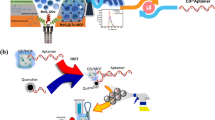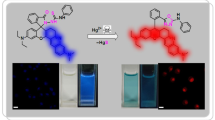Abstract
A series of four imidazole based fluorescent receptors (R1-R4) containing two different signaling units were synthesized for the sensing of specific anions. R1 and R2 act as excellent colorimetric sensors via color change from yellow to orange and pink in presence of F−, AcO− and CN− ions. R1 and R2 show intramolecular charge transfer (ICT) band at 414 nm and 434 nm and were red shifted into 500 nm and 510 nm respectively, with the addition of above anions. Anion complexes of R1 and R2 were found to exhibit remarkable orange and red fluorescence under UV light which is consistent with an emission observed at 594 nm and 618 nm respectively. Likewise, quenching in the green fluorescence of R3 and R4 was found under UV light accompanied with quenching of emission at 530 nm and 541 nm. Selective colorimetric sensing of CN− ion is also achieved in 3 % aq. DMF medium. Intracellular uptake of CN− ion by R1 was achieved in living RAW 264.7 cells. Finally, practical application of R2 to detect CN− and F− ions present in aqueous solution of cassava flour and toothpaste also performed.














Similar content being viewed by others
References
Schmidtchen FP, Berger M (1997) Artificial organic host molecules for anions. Chem Rev 97:1609–1646
Suksai C, Tuntulani T (2003) Chromogenic anion sensors. Chem Soc Rev 32:192–202
Martınez-Manez R, Sancenon F (2006) Chemodosimeters and 3D inorganic functionalised hosts for the fluoro-chromogenic sensing of anions. Coord Chem Rev 250:3081–3093
Gale PA, Garcia-Garrido SE, Garric J (2008) Receptors Based on Organic Frameworks: Highlights from 2005 and 2006. Chem Soc Rev 37:151–190
Lou X, Ou D, Li Q, Li Z (2012) An indirect approach for anion detection: the displacement strategy and its application. Chem Commun 48:8462–8477
Garcia-Garrido SE, Caltagirone C, Light ME, Gale PA (2007) Acridinone-based anion receptors and sensors. Chem Commun 43:1450–1452
Wu J, Liu W, Ge J, Zhang H, Wang P (2011) New sensing mechanisms for design of fluorescent chemosensors emerging in recent years. Chem Soc Rev 40:3483–3495
Gunnlaugsson T, Davis AP, O’Brien JE, Glynn M (2005) Synthesis and photophysical evaluation of charge neutral thiourea or urea based fluorescent PET sensors for bis-carboxylates and pyrophosphate. Org Biomol Chem 3:48–56
Yeo HM, Ryu BJ, Nam KC (2008) A novel fluoride ion colorimetric chemosensor. Org Lett 10:2931–2934
Thangadurai TD, Singh NJ, Hwang I, Lee JW, Chandaran RP, Kim KS (2007) 2-dimensional analytic approach for anion differentiation with chromofluorogenic receptors. J Org Chem 72:5461–5464
Manivannan R, Satheshkumar A, Elango KP (2013) Tuning of the H-bonding ability of imidazole N–H towards the colorimetric sensing of fluoride and cyanide ions as their sodium salts in water. New J Chem 37:3152–3160
Bhaumik C, Saha D, Das S, Baitalik S (2011) Synthesis, structural characterization, photophysical, electrochemical, and anion-sensing studies of luminescent homoand heteroleptic ruthenium(II) and osmium(II) complexes based on terpyridyl-imidazole ligand. Inorg Chem 50:12586–12600
Mashraqui SH, Ghorpade SS, Tripathi S, Britto S (2012) A new indole incorporated chemosensor exhibiting selective colorimetric and fluorescence ratiometric signaling of fluoride. Tetrahedron Lett 53:765–768
Suganya S, Park JS, Velmathi S (2014) Visual sensing of aqueous anions by C2-symmetric chemosensor and its application in real sample analysis. Sensors Actuators B Chem 190:679–684
Wu Y, Peng X, Fan J, Gao S, Tian M, Zhao J, Sun S (2007) Fluorescence sensing of anions based on inhibition of excited-state intramolecular proton transfer. J Org Chem 72:62–70
Goswami S, Das AK, Sen D, Aich K, Fun HK, Quah CK (2012) A simple naphthalene-based colorimetric sensor selective for acetate. Tetrahedron Lett 53:4819–4823
Hosseini M, Ganjali MR, Veismohammadi B, Faridbod F, Abkenar SD, Niasari MS (2012) Selective recognition of acetate ion based on fluorescence enhancement chemosensor. Luminescence 27:341–345
Xu Z, Chen X, Kim HN, Yoon J (2010) Sensors for the optical detection of cyanide ion. Chem Soc Rev 39:127–137
Tomasulo M, Sortino S, White AJP, Raymo FM (2006) Chromogenic oxazines for cyanide detection. J Org Chem 71:744–753
Yang YK, Tae J (2006) Acridinium salt based fluorescent and colorimetric chemosensor for the detection of cyanide in water. Org Lett 8:5721–5723
Lou X, Zhang L, Qin J, Li Z (2008) An alternative approach to develop a highly sensitive and selective chemosensor for the colorimetric sensing of cyanide in water. Chem Commun 5848–5850
Chen X, Nam SW, Kim GH, Song N, Jeong Y, Shin I, Kim SK, Kim J, Park S, Yoon J (2010) A near-infrared fluorescent sensor for detection of cyanide in aqueous solution and its application for bioimaging. Chem Commun 46:8953–8955
Cheng X, Tang R, Jia H, Feng J, Qin J, Li Z (2012) New fluorescent and colorimetric probe for cyanide: direct reactivity, high selectivity and bioimaging application. ACS Appl Mater Interfaces 4:4387–4392
Li AF, Wang JH, Wang F, Jiang YB (2010) Anion complexation and sensing using modified urea and thiourea-based receptors. Chem Soc Rev 39:3729–3745
Chauhan SMS, Bisht T, Garg B (2008) Anion sensing by phenazine-based urea/thiourea receptors. Tetrahedron Lett 49:6646–6649
Amilan Jose D, Kumar DK, Ganguly B, Das A (2004) Efficient and simple colorimetric fluoride ion sensor based on receptors having urea and thiourea binding sites. Org Lett 6:3445–3448
Kim YJ, Kwak H, Lee SJ, Lee JS, Kwon HJ, Nam SH, Lee K, Kim C (2006) Urea/thiourea-based colorimetric chemosensors for the biologically important ions: efficient and simple sensors. Tetrahedron 62:9635–9640
Jeon NJ, Hong SW, Hong J, Jeong J, Nam KC (2012) Turn-on fluorescent chemosensor for fluoride based on pyrene amide derivative. Bull Kor Chem Soc 33:313–315
Kang SO, Hossain Md A, James KB (2006) Influence of dimensionality and charge on anion binding in amide-based macrocyclic receptors. Coord Chem Rev 250:3038–3052
You J, Jeong H, Seo H, Jeon S (2010) A new fluoride ion colorimetric sensor based on dipyrrolemethanes. Sensors Actuators B Chem 146:160–164
Chang KJ, Moon D, Lah MS, Jeong KS (2005) Indole-based macrocycles as a class of receptors for anions. Angew Chem In Ed 117:8140–8143
Nishiyabu R, Palacios MA, Dehaen W, Anzenbacher Jr P (2006) Synthesis, structure, anion binding, and sensing by calix[4]pyrrole isomers. J Am Chem Soc 128:11496–11504
Sessler JL, Cho WS, Gross DE, Shriver JA, Lynch VM, Marquez M (2005) Anion binding studies of fluorinated expanded calixpyrroles. J Org Chem 70:5982–5986
Suganya S, Velmathi S (2013) Simple azo-based salicylaldimine as colorimetric and fluorescent probe for detecting anions in semi-aqueous medium. J Mol Recognit 26:259–267
Yu M, Lin H, Zhao G, Lin H (2007) A benzimidazole-based chromogenic anion receptor. J Mol Recognit 20:69–73
Molina P, Tarraga A, Oton F (2012) Imidazole derivatives: a comprehensive survey of their recognition properties. Org Biomol Chem 10:1711–1724
Saha D, Das S, Bhaumik C, Dutta S, Baitalik S (2010) Monometallic and bimetallic ruthenium(II) complexes derived from 4,5-bis(benzimidazol-2-yl)imidazole (H3Imbzim) and 2,2′-bipyridine as colorimetric sensors for anions: synthesis, characterization, and binding studies. Inorg Chem 49:2334–2348
Lin TP, Chen CY, Wen YS, Sun SS (2007) Synthesis, photophysical, and anion-sensing properties of quinoxalinebis(sulfonamide) functionalized receptors and their metal complexes. Inorg Chem 46:9201–9212
Batista RMF, Costa SPG, Raposo MMM (2013) Naphthyl-imidazo-anthraquinones as novel colorimetric and fluorimetric chemosensors for ion sensing. J Photochem Photobiol A 259:33–40
Peng X, Wu Y, Fan J, Tian M, Han K (2005) Colorimetric and ratiometric fluorescence sensing of fluoride: tuning selectivity in proton transfer. J Org Chem 70:10524–10531
Kumar S, Luxami V, Kumar A (2008) Chromofluorescent probes for selective detection of fluoride and acetate ions. Org Lett 10:5549–5552
Batista RMF, Oliveira E, Costa SPG, Lodeiro C, Raposo MMM (2007) Synthesis and ion sensing properties of new colorimetric and fluorimetric chemosensors based on bithienyl-imidazo-anthraquinone chromophores. Org Lett 9:3201–3204
Wannalerse B, Tuntulani T, Tomapatanaget B (2008) Synthesis, optical and electrochemical properties of new receptors and sensors containing anthraquinone and benzimidazole units. Tetrahedron 64:10619–10624
Kumari N, Jha S, Bhattacharya S (2011) Colorimetric probes based on anthraimidazolediones for selective sensing of fluoride and cyanide ion via intramolecular charge transfer. J Org Chem 76:8215–8222
Zapata F, Caballero A, Espinosa A, Ta’rraga A, Molina P. (2009). Imidazole-annelated ferrocene derivatives as highly selective and sensitive multichannel chemical probes for Pb(II) cations. J Org Chem 74: 4787–4796.
Shi BB, Zhang Y, Wei T, Lin Q, Yao H, Zhang P, You X (2014) A Fluorescent and Colorimetric Chemosensor for Dihydrogenphosphate ions Based on 2-Pyridine-1H-Imidazo [4,5-B]Phenazine–Zinc Ensemble. Sensors Actuators B Chem 190:555–561
Shi BB, Zhang P, Wei T, Yao H, Lin Q, Liu J, Zhang Y (2013) A reversible fluorescent chemosensor for mercury ions based on 1H-imidazo[4,5-b]phenazine derivatives. Tetrahedron 69:7981–7987
Gao G, Qu W, Shi B, Zhang P, Lin Q, Yao H, Yang W, Zhang Y, Wei T (2014) A highly selective fluorescent chemosensor for iron ion based on 1 H-imidazo [4, 5-B] phenazine derivative. Spectrochim Acta A 121:514–519
Yang L, Li X, Yang J, Qu Y, Hua J (2013) Colorimetric and ratiometric near-infrared fluorescent cyanide chemodosimeter based on phenazine derivatives. ACS Appl Mater Interfaces 5:1317–1326
Qu Y, Hua J, Tian H (2010) Colorimetric and ratiometric red fluorescent chemosensor for fluoride ion based on diketopyrrolopyrrole. Org Lett 12:3320–3323
Sondhi SM, Singh J, Roy P, Agrawal SK, Saxena AK (2011) Conventional and microwave-assisted synthesis of imidazole and guanidine derivatives and their biological evaluation. Med Chem Res 20:887–897
Mavrodi DV, Blankenfeldt W, Thomashow LS (2006) Phenazine Compounds in Fluorescent Pseudomonas Spp. biosynthesis and regulation. Annu Rev Phytopathol 44:417–445
Zuyun H, Houping H, Ruxiu C, Yune Z (1998) Organic solvent enhanced spectrofluorimetric method for determination of laccase activity. Anal Chim Acta 374:99–103
Hu S, Zhang S, Hu Y, Tao Q, Wu A (2013) A new selective pyrazoline-based fluorescent chemosensor for Cu2+ in aqueous solution. Dyes Pigments 96:509–515
Saha S, Ghosh A, Mahato P, Mishra S, Mishra SK, Suresh E, Das S, Das A (2010) Specific recognition and sensing of CN− in sodium cyanide solution. Org Lett 12:3406–3409
Satheshkumar A, Elango KP (2013) Spectral and DFT studies on simple and selective colorimetric sensing of fluoride ions Via enhanced charge transfer using a novel signaling unit. Dyes Pigments 96:364–371
Burns AE, Bradbury JH, Cavagnaro TR, Gleadow RM (2012) Total cyanide content of cassava food products in Australia. J Food Compos Anal 25:79–82
Nandi LG, Nicoleti CR, Bellettini IC, Machado VG (2014) Optical chemosensor for the detection of cyanide in water based on ethyl(hydroxyethyl)cellulose functionalized with brooker’s merocyanine. Anal Chem 86:4653–4656
Author information
Authors and Affiliations
Corresponding author
Electronic supplementary material
Scheme 1, selected UV-vis and fluorescence graphs are available in Supplementary data.
ESM 1
(DOCX 1462 kb)
Rights and permissions
About this article
Cite this article
Suganya, S., Park, J.S. & Velmathi, S. Highly Fluorescent Imidazole Probes for the Pico Molar Detection of CN− ion and Application in Living Cells. J Fluoresc 26, 207–215 (2016). https://doi.org/10.1007/s10895-015-1702-2
Received:
Accepted:
Published:
Issue Date:
DOI: https://doi.org/10.1007/s10895-015-1702-2




